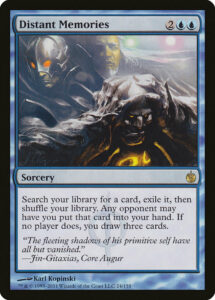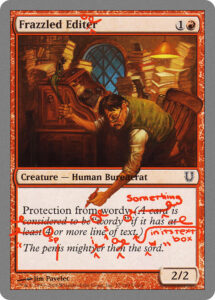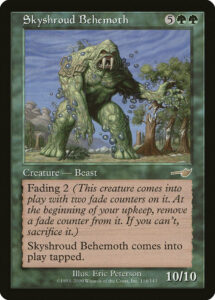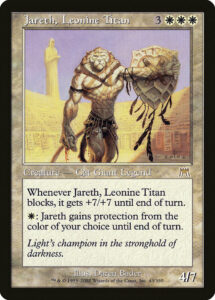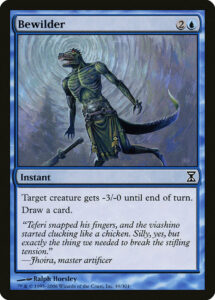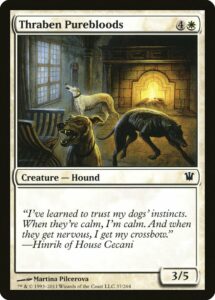One of my favorite aspects of Magic: the Gathering is cube. It’s an ongoing exercise in game design, where you curate your own format out of the thousands of game pieces Magic has created over almost thirty years. It’s a social activity where you meet up your friends and play games designed for you to enjoy, all the while learning from everyone’s play experiences and discussing cube design with them. It’s a hobby where you endlessly fiddle with and spend money on your beloved creation, like a restored car or creating stained glass windows.
Cube at a Distance
The pandemic has complicated cube design, but it certainly hasn’t curtailed it. I still purchase singles for my cube (and all the cubes I toy with making but haven’t yet made). It’s awkward making cuts and additions, since the cards I’ve added to my flex slots (like Inscription of Insight) end up on the chopping block despite never actually being playtested. But this is not only a solvable problem, but one with multiple solutions.
This is the problem of remote playtesting, one which I’ve had to solve in multiple ways for work.
- Build a Magic Online cube. I had the pleasure of drafting Sniffygull’s Monkey Cube on Magic Online. While the expense, risk, and time investment of creating and lending out a Magic Online cube isn’t for everyone, it’s the best way to cube draft remotely.
- Build a Magic Arena cube. This has been a slow project for the past month. It avoids the expense and lending logistics of a Magic Online cube, but requires all participants to have enough wildcards or a big enough collection to play. I’ve been enjoying the design constraints of only using Historic legal cards, not just duplicating the Arena Cube, and including a high density of commons and uncommons (since it could be too expensive for people to draft if it’s all rares and mythics).
- Play other cubes. While I haven’t been able to playtest my own cube, I have been able to play other cubes, like the excellent most recent iteration of the Arena Cube and Sniffygull’s aforementioned Monkey Cube. While their power level and card curation are different from mine, both allow me to test out new cards in a cube. It’s not a perfect replacement for a playtest, but it’s an acceptable solution that works both within the pandemic and outside of it.
- Drafting isn’t everything. You can’t design a finished game and ship it without loads of playtesting, just as you can’t make a fun, balanced cube without playing it. But a hobby isn’t a job—there is plenty of enjoyment to be had in the theorycrafting, the curation, and the collecting of a cube, even if it can’t be played with for the moment. Heck, in 2019, I only drafted my cube once, but I still invested plenty of time, money, and energy into it and reaped plenty of enjoyment.
This last point is critical. There’s ample fun to be had in the parts of cube that precede play. And once I gave myself permission to step away from my cube that I can’t play, I remembered there’s something I’ve wanted to design for years, but never got around to. Sure, it also isn’t possible to playtest easily in the pandemic, but it’s a fun exercise in and of itself. If I could modify the cards themselves, what would I do?
Custom Cubing
I’m certainly not the first person to think about modifying cards with stickers, but it’s nevertheless an exciting endeavor to muck about with the game pieces. And as soon as I started modding cards, it became clear that I needed to decide to what standards I wanted to change them. After all, it’s not hard to turn almost any card into something better than Black Lotus—reduce the mana cost to 0, increase other numbers by 10, and maybe add some card draw or direct damage, and you’ve created something utterly ludicrous.
So instead, I tried to make things be playable in my cube (which is a middle-of-the-road power level that draws from all sets and rarities) without making them top 20 cards in the cube. And rather than start with some of my favorite cards that just aren’t good enough (here’s looking at you, Ojutai Exemplars), I instead opted for silly fun: I got on the phone with my good friend Sam, he hit Random Card on Scryfall, and I modded on the fly.
Blasto-darn
Skyshroud Behemoth is an incredibly forgettable card. It’s a big Tammy card, but the massive Spikey downside makes it appealing to very few people. But what if it cost 2GG just like Blastoderm? Both of them live just long enough to do 20 damage; but Skyshroud Behemoth is vulnerable to spot removal, is much easier to chump block, and can’t even block the turn it comes into play. And in my cube, there’s a fair bit of Deathtouch and plenty of token creation—I wouldn’t be surprised if it’s so easily blanked that it could even be fair at 1GG. That’d be a fun experiment to try out.
And with this first foray back into the penultimate set of my childhood, I couldn’t stop.
Stasis isn’t fun
Our next random card had more text and a less clean solution. Jareth, Leonine Titan is a defensive behemoth designed to slow the game down. It punishes all non-evasive blockers but his meager 4 power provides little incentive to end the game. I wanted to skip Jareth and go to something with a play pattern I’d preferred. (I think it’s best if top end cards actually finish the game rather than draw it out.) But it was jamming with Sam and I didn’t want to abandon the game so soon.
So, how could we change Jareth to encourage attacking rather than sitting back behind his protective Righteousness and built-in Mother of Runes? The obvious answer is giving him Vigilance, but I opted for something a bit more drastic. What if he got +7/+7 whenever he blocked or attacked? An 11 power attacker is nothing to sneer at. Granted, an 11 power attacker protected from almost all interaction and blockers for one white mana isn’t exactly where I want him to land, so I made a second change: his ability instead costs 3W to activate. So you can threaten an activation with him, but you can’t easily get him by all blockers or Stave Off all removal spells.
Bewilder offers an awkward chance at card advantage, but it’s not exactly a powerhouse card. It’s already been obviated by Befuddle and looks unimpressive next to Stream of Consciousness and Chilling Trap. The easy choice is to just make it a souped up Fleeting Distraction, but I chose to instead let it draw two cards. As an instant speed Divination, the play pattern shifts from trying to squeeze out value from an awkward card to a solid card advantage generator that requires some board presence to be cast (and lives in fear of enemy sacrifice effects or instant speed removal) and can occasionally turn into a 3-for-1.
Even the simplest cards don’t have clean answers. How ought you to upgrade Thraben Purebloods to fit a moderately powerful cube? Do you keep its stats and drop its cost to 2W (which, next to Brimaz, King of Oreskos still doesn’t exactly dazzle)? Do you keep it at 4W and beef its stats to silly heights? Do you add extra abilities and make it into a vastly improved Rambunctious Mutt? If even a quarter of all cards in a cube were so upgraded, just how difficult would it be for everyone to keep track of all these modified, but mildly familiar cards?
All good questions, but thankfully, questions beyond the current scope of the endeavor. Right now, I just get to enjoy a little bit of modding with my friend. Not being able to playtest anytime soon in this case is a luxury that lets me fool around without (yet) the amount of work it’d take to push this towards a finished product. And that permission to play is a nice silver lining to the situation at hand.
Zachary Barash is a New York City-based game designer and the commissioner of Team Draft League. He designs for Kingdom Death: Monster, has a Game Design MFA from the NYU Game Center, and does freelance game design. When the stars align, he streams Magic (but the stars align way less often than he’d like).

